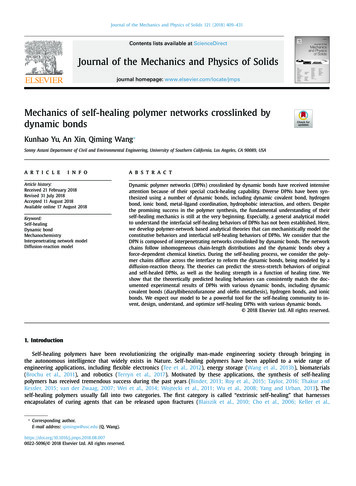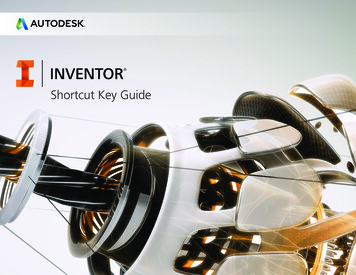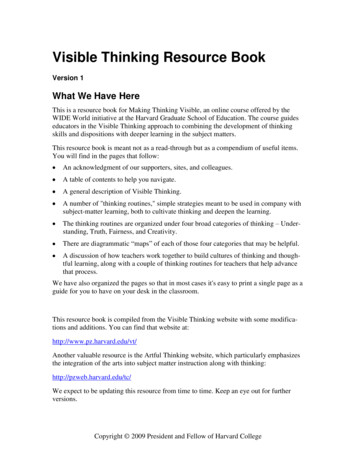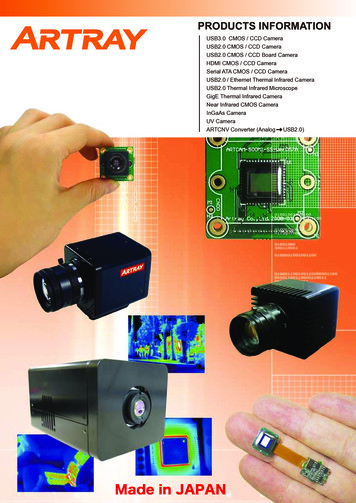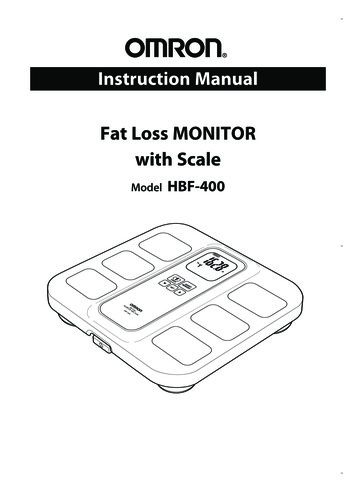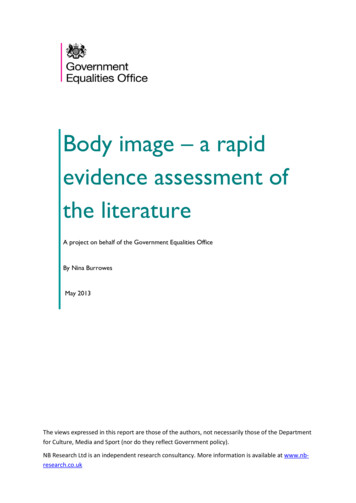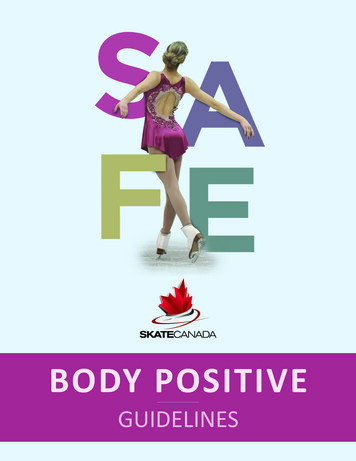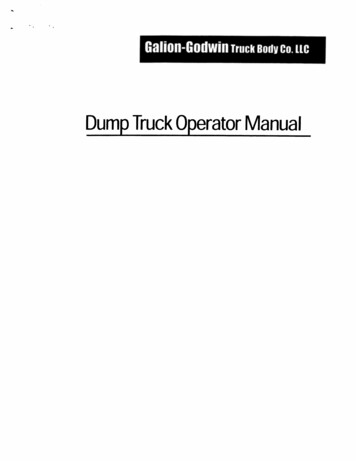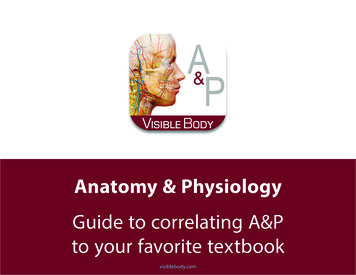
Transcription
visiblebody.com
Essentials of Human Anatomy, 10th Editionby Elaine N. MariebHole’s Human Anatomy & Physiology, 14th Editionby David Shier, Jackie Butler, and Ricki LewisHuman Anatomy & Physiology, 9th Editionby Elaine N. Marieb and Katja HoehnSeeley’s Anatomy & Physiology, 11th Edition byCinnamon VanPutte, Jennifer Regan, and Andrew RussFundamentals of Anatomy and Physiology, 9th Editionby Frederic H. Martini, Judi L. Nath, and Edwin F. BartholomewAnatomy & Physiology: An Integrative Approachby Michael P. McKinley, Valerie Dean O'Loughlin, and Theresa Stouter BidleAnatomy & Physiology: The Unity of Form and Function, 6th Editionby Kenneth S. SaladinPrinciples of Anatomy and Physiology, 13th Editionby Gerard J. Tortora and Bryan DerricksonSyllabus Correlation for Anatomy & Physiologyfrom Open Staxvisiblebody.com
Syllabus Correlation for Essentials of Human Anatomy, 10th Editionby Elaine N. MariebMarieb Chapter NameVisible Body’s Anatomy & Physiology UnitKey HighlightsChapter 1: The Human Body: AnOrientationChapter 2: Basic ChemistryChapter 3: Cells and TissuesChapters 1-4: Cells & Tissue3D models explore epithelial, connective, and muscle tissue. Tissue repair andscarring are featured in an animation and 3D model. Plus three new animations oncellular respiration, transcription, and translation.Chapter 4: Skin and BodyMembranesChapters 5-6: Integumentary SystemStunning animation on tissue repair. 3D models of epidermis and dermis layers.Chapter 5: The Skeletal SystemChapters 7-12: Skeletal System and JointsAnimations on formation of flat bones, long bones, and bone repair. 3D modelsinclude key bony landmarks of all of the major bones. Animations show movementof all joint types.Chapter 6: The Muscular SystemChapters 13-16: Muscle Tissue and MuscularSystemMore than 50 3D models of muscle groups. Two new animations on skeletalmuscle contraction featuring action potential and cross-bridge formation.Chapter 7: The Nervous SystemChapters 17-23: Nervous System and SpecialSenses3D models of the brain and cranial nerves, spinal cord and spinal nerves, aswell as animations and 3D models of somatic and autonomic functions,somatic sensory signals, and skin sensory receptors. Illustrations of types ofneurons and neuron structure. Includes animation of neuron function.Chapter 8: Special SensesChapters 17-23: Nervous System and SpecialSenses3D models and animations on olfactory pathway and process ofolfaction, tongue and taste, eyes and vision, ears and hearing.Chapter 9: The Endocrine SystemChapters 24-26: Endocrine SystemAnimation on hormone actions, as well as 3D models and explanation of majororgans and functions.Chapter 10: BloodChapter 27: Introduction; Chapter 28: BloodAnimations on blood plasma, production of red blood cells, function of red blood cells,and function of platelets.Chapter 11: The CardiovascularSystemChapter 27: Introduction; Chapter 29: Heart;Chapter 30: Blood Vessels and CirculationMore than 70 assets detailing arteries, veins, and vessels in 3D. Includes animations onheart chambers, heart valves, heart conduction, and more.Chapter 12: The Lymphatic Systemand Body DefensesChapters 31-33: Lymphatic System3D models of key organs as well as vessels and veins, lymph node function and distribution,and types of immunity.Chapter 13: The Respiratory SystemChapters 34-37: Respiratory System3D models of all major respiratory structures. Animations include physiology of nasalmucosa, sneezing, function of the epiglottis, phonation, and function of the trachea and bronchi.Chapter 14: The Digestive Systemand Body MetabolismChapters 38-42: Digestive SystemAnimations include chewing and swallowing, peristalsis, and absorption. 3D models dive deepinto primary and accessory organs of digestion.Chapter 15: The Urinary SystemChapters 43-46: Urinary SystemAnimations include filtration and reabsorption and secretion. Illustrations show filtrationmembrane and urine composition. 3D models explore kidneys, ureters, bladder, urethra andmicturition reflex.Chapter 16: The ReproductiveSystemChapters 47-50: Reproductive SystemMale and female reproductive anatomy, including animations on spermatogenesis andoogenesis. Models and illustrations cover ovulation, path of the zygote, and birth.Animations show lactation and fetal development.visiblebody.com
Syllabus Correlation for Human Anatomy & Physiology, 9th Editionby Elaine N. Marieb and Katja HoehnMarieb Chapter NameVisible Body’s Anatomy & Physiology UnitKey HighlightsChapter 1: The Human Body: AnOrientationChapter 2: Chemistry Comes AliveChapter 3: Cells: The Living UnitsChapters 1-4: Cells & TissueThree new animations on cellular respiration, transcription, and translation.Chapter 4: Tissue: The Living FabricChapters 1-4: Cells & Tissue3D models explore epithelial, connective, and muscle tissue. Tissue repair and scarringare featured in an animation and 3D model.Chapter 5: The Integumentary SystemChapters 5-6: Integumentary SystemStunning animation on tissue repair. 3D models of epidermis and dermis layers.Chapter 6: Bones and Skeletal TissuesChapters 7-12: Skeletal System and JointsAnimations on formation of flat bones, long bones, and bone repair.Chapter 7: The SkeletonChapters 7-12: Skeletal System and JointsNow with 3D models that include key bony landmarks of all of the major bones.Chapter 8: JointsChapter 12: JointsAnimations showing movement of all joint types.Chapter 9: Muscles and MuscleTissueChapters 13-16: Muscle Tissue and MuscularSystemTwo new animations on skeletal muscle contraction featuring actionpotential and cross-bridge formation.Chapter 10: The Muscular SystemChapters 13-16: Muscle Tissue and MuscularSystemMore than 50 3D models of muscle groups.Chapter 11: The Fundamentals of theNervous System and Nervous TissueChapters 17-23: Nervous System and SpecialSensesIllustrations of types of neurons and neuron structure. Includesanimation of neuron function.Chapter 12: The Central NervousSystemChapters 17-23: Nervous System and SpecialSenses3D models of the brain, spinal cord, and spinal nerves showing anatomyand innervation.Chapter 13: The Peripheral Nervousstem and eflex Acti itChapters 17-23: Nervous System and SpecialSensesIncludes animations and 3D models of somatic and autonomic functions, as well assomatic sensory signals and skin sensory receptors.Chapter 14: The Autonomic NervousSystemChapters 17-23: Nervous System and SpecialSenses3D model to convey autonomic nervous functions.Chapter 15: The Special SensesChapters 23: Special Senses3D models and animations on olfactory pathway and process of olfaction, tongue and taste,eyes and vision, and ears and hearing.Chapter 16: The Endocrine SystemChapters 24-26: Endocrine SystemAnimation on hormone actions, as well as 3D models and explanation of major organs andfunctions.Chapter 17: BloodChapter 27: Introduction; Chapter 28: BloodAnimations on blood plasma, production of red blood cells, function of red blood cells, andfunction of platelets.Chapter 18: The CardiovascularSystem: The HeartChapter 27: Introduction; Chapter 29: HeartMore than 25 assets on anatomy in 3D, including animations on heart chambers, heart valves,heart conduction, and more.Chapter 19: The CardiovascularSystem: Blood VesselsChapter 27: Introduction; Chapter 30: BloodVessels and CirculationMore than 55 assets detailing arteries and veins in 3D.Chapter 20: The Lymphatic Systemand Lymphoid Organs and TissuesChapters 31-33: Lymphatic System3D models of key organs, as well as vessels and veins and lymph nodefunction and distribution.Chapter 21: The Immune System:Innate and Adaptive Body DefensesChapters 31-33: Lymphatic SystemPhagocytosis animation and illustrations on innate immunity, adaptive immunity,and types of white blood cells. 3D models of B and T cells.visiblebody.com
Chapter 22: The Respiratory SystemChapters 34-37: Respiratory System3D models of all major respiratory structures. Animations include physiology of nasal mucosa, sneezing,function of the epiglottis, phonation, and function of the trachea and bronchi.Chapter 23: The Digestive SystemChapters 38-42: Digestive SystemAnimations include chewing and swallowing, peristalsis, and absorption. 3D models dive deep into primaryand accessory organs of digestion.Chapter 24: Nutrition, Metabolism,and Body Temperature RegulationChapters 38-42: Digestive System;Chapters 24-26: Endocrine System3D models include the pancreas and pancreatic islets, and hypothalamus.Chapter 25: The Urinary SystemChapters 43-46: Urinary SystemAnimations include filtration and illustrations show filtration membrane and urine composition. 3Dmodels explore idne s, ureters, bladder, urethra, and micturition reflex.Chapter 26: Fluid, Electrolyte, andAcid-Base BalanceChapters 43-46: Urinary SystemAnimations include reabsorption and secretion.Chapter 27: The Reproductive SystemChapters 47-50: Reproductive SystemMale and female reproductive anatomy, including animations on spermatogenesis and oogenesis.Chapter 28: Pregnancy and HumanDevelopmentChapters 47-50: Reproductive SystemModels and illustrations cover ovulation, path of the zygote, and birth. Animations show lactation and fetaldevelopment.Chapter 29: HeredityChapters 47-50: Reproductive System;Chapters 2-3: Cell Structure and Functionand Cell Life CycleDNA illustrations, as well as transcription and translation animations and illustrations. Animation featuresan overview of the reproductive system.visiblebody.com
Syllabus Correlation for Fundamentals of Anatomy and Physiology, 9th Editionby Frederic H. Martini, Judi L. Nath, and Edwin F. BartholomewMartini Chapter NameVisible Body’s Anatomy & Physiology UnitKey HighlightsChapter 1: An Introduction toAnatomy and PhysiologyChapter 2: The Chemical Level ofOrganizationChapter 3: The Cellular Level ofOrganizationChapters 1-4: Cells & TissueThree new animations on cellular respiration, transcription, and translation.Chapter 4: The Tissue Level ofOrganizatonChapters 1-4: Cells & Tissue3D models explore epithelial, connective, and muscle tissue. Tissue repair andscarring are featured in an animation and 3D model.Chapter 5: The IntegumentarySystemChapters 5-6: Integumentary SystemStunning animation on tissue repair. 3D models of epidermis and dermis layers.Chapter 6: Osseous Tissue and BoneStructureChapters 7-9: Skeletal System and JointsAnimations on formation of flat bones, long bones, and bone repair.Chapter 7: The Axial SkeletonChapter 10: Axial SkeletonNow with 3D models that include key bony landmarks of allmajor bones.Chapter 8: The AppendicularSkeletonChapter 11: Appendicular SkeletonNow with 3D models that include key bony landmarks of allmajor bones.Chapter 9: ArticulationsChapter 12: JointsAnimations showing movement of all joint types.Chapter 10: Muscle TissueChapters 13-16: Muscle Tissue and MuscularSystemTwo new animations on skeletal muscle contraction featuring actionpotential and cross-bridge formation.Chapter 11: The Muscular SystemChapters 13-16: Muscle Tissue and MuscularSystemMore than 50 3D models of muscle groups.Chapter 12: Neural TissueChapters 17-23: Nervous System and SpecialSensesIllustrations of types of neurons and neuron structure. Includes animationof neuron function.Chapter 13: The Spinal Cord, Spinaler es, and pinal eflexesChapters 17-23: Nervous System and SpecialSenses3D models of the spinal cord and spinal nerves showing anatomy and innervation.Chapter 14: The Brain and CranialNervesChapters 17-23: Nervous System and SpecialSenses3D models of the brain and cranial nerves showing anatomy and innervation.Chapter 15: Neural Integration I:Sensory Pathways and the SomaticNervous SystemChapters 17-23: Nervous System and SpecialSensesIncludes animations and 3D models of somatic and autonomic functions, as well as somaticsensory signals and skin sensory receptors.Chapter 16: Neural Integration II:The Autonomic Nervous System andHigher-Order FunctionsChapters 17-23: Nervous System and SpecialSenses3D model to convey autonomic nervous functions.Chapter 17: The Special SensesChapters 23: Special Senses3D models and animations on olfactory pathway and process of olfaction, tongue and taste,eyes and vision, and ears and hearing.Chapter 18: The Endocrine SystemChapters 24-26: Endocrine SystemAnimation on hormone actions, as well as 3D models and explanation of major organsand functions.visiblebody.com
Chapter 19: BloodChapter 27: Introduction; Chapter 28: BloodAnimations on blood plasma, production of red blood cells, function of red blood cells, and function ofplatelets.Chapter 20: The HeartChapter 27: Introduction; Chapter 29: HeartMore than 25 assets on anatomy in 3D, including animations on heart chambers, heart valves, heartconduction, and more.Chapter 21: Blood Vessels andCirculationChapter 27: Introduction; Chapter 30: BloodVessels and CirculationMore than 55 assets detailing arteries and veins in 3D.Chapter 22: The Lymphatic Systemand ImmunityChapters 31-33: Lymphatic System3D models of key organs, as well as vessels and veins, lymph node function and distribution, and typesof immunity.Chapter 23: The Respiratory SystemChapters 34-37: Respiratory System3D models of all major respiratory structures. Animations include physiology of nasal mucosa, sneezing,function of the epiglottis, phonation, and function of the trachea and bronchi.Chapter 24: The Digestive SystemChapters 38-42: Digestive SystemAnimations include chewing and swallowing, peristalsis, and absorption. 3D models dive deep into primaryand accessory organs of digestion.Chapter 25: Metabolism andEnergeticsChapters 38-42: Digestive System;Chapters 24-26: Endocrine System3D models include the pancreas and pancreatic islets, and hypothalamus.Chapter 26: The Urinary SystemChapters 43-46: Urinary SystemAnimations include filtration and illustrations show filtration membrane and urine composition. 3Dmodels explore idne s, ureters, bladder, urethra, and micturition reflex.Chapter 27: Fluid, Electrolyte, andAcid-Base BalanceChapters 43-46: Urinary SystemAnimations include reabsorption and secretion.Chapter 28: The ReproductiveSystemChapters 47-50: Reproductive SystemMale and female reproductive anatomy, including animations on spermatogenesis and oogenesis.Chapter 29: Development andInheritanceChapters 47-50: Reproductive System;Chapters 2-3: Cell Structure and Functionand Cell Life CycleModels and illustrations cover ovulation, path of the zygote, birth, transcription, and translation. Animationsshow lactation and fetal development.visiblebody.com
Syllabus Correlation for Anatomy & Physiology: An Integrative Approachby Michael P. McKinley, Valerie Dean O’Loughlin, Theresa Stouter BidleMcKinley Chapter NameVisible Body’s Anatomy & Physiology UnitKey HighlightsChapter 1: The Sciences of Anatomyand PhysiologyChapter 2: Atoms, Ions, andMoleculesChapter 3: Energy, ChemicalReactions, and Cellular RespirationChapters 1-4: Cells & TissueNew animation on cellular respiration.Chapter 4: Biology of the CellChapters 1-4: Cells & TissueIn-depth animations and illustrations of transcription and translation.Chapter 5: Tissue OrganizatonChapters 1-4: Cells & Tissue3D models explore epithelial, connective, and muscle tissue. Tissue repair andscarring are featured in an animation and 3D model.Chapter 6: Integumentary SystemChapters 5-6: Integumentary SystemStunning animation on tissue repair. 3D models of epidermis and dermis layers.Chapter 7: Skeletal System: BoneStructure and FunctionChapters 7-9: Skeletal System and JointsAnimations on formation of flat bones, long bones, and bone repair.Chapter 8: Skeletal System: Axialand Appendicular SkeletonChapter 10: Axial Skeleton;Chapter 11: Appendicular SkeletonNow with 3D models that include key bony landmarks of all the major bones.Chapter 9: Skeletal System:ArticulationsChapter 12: JointsAnimations showing movement of all joint types.Chapter 10: Muscle TissueChapters 13-16: Muscle Tissue and MuscularSystemTwo new animations on skeletal muscle contraction featuring actionpotential and cross-bridge formation.Chapter 11: Muscular System: Axialand Appendicular MusclesChapters 13-16: Muscle Tissue and MuscularSystemMore than 50 3D models of muscle groups.Chapter 12: Nervous System:Nervous TissueChapters 17-23: Nervous System and SpecialSensesIllustrations of types of neurons and neuron structure. Includes animationof neuron function.Chapter 13: Nervous System: Brainand Cranial NervesChapters 17-23: Nervous System and SpecialSenses3D models of the brain and cranial nerves showing anatomy and innervation.Chapter 14: Nervous System: SpinalCord and Spinal NervesChapters 17-23: Nervous System and SpecialSenses3D models of the spinal cord and spinal nerves showing anatomy and innervation.Chapter 15: Nervous System:Autonomic Nervous SystemChapters 17-23: Nervous System and SpecialSenses3D model to convey autonomic nervous functions.Chapter 16: Nervous System: SensesChapters 23: Special Senses3D models and animations on olfactory pathway and process of olfaction, tongue and taste,eyes and vision, and ears and hearing.Chapter 17: Endocrine SystemChapters 24-26: Endocrine SystemAnimation on hormone actions, as well as 3D models and explanation of major organsand functions.Chapter 18: Cardiovascular System:BloodChapter 27: Introduction; Chapter 28: BloodAnimations on blood plasma, production of red blood cells, function of red blood cells,and function of platelets.Chapter 19: Cardiovascular System:HeartChapter 27: Introduction; Chapter 29: HeartMore than 25 assets on anatomy in 3D, including animations on heart chambers, heartvalves, heart conduction, and more.visiblebody.com
Chapter 20: Cardiovascular System:Vessels and CirculationChapter 27: Introduction; Chapter 30: BloodVessels and CirculationMore than 55 assets detailing arteries and veins in 3D.Chapter 21: Lymphatic SystemChapters 31-33: Lymphatic System3D models of key organs, as well as vessels and veins and lymph node function and distribution.Chapter 22: Immune System and theBody’s DefenseChapters 31-33: Lymphatic SystemPhagocytosis animation and illustrations on innate immunity, adaptive immunity, and types of white bloodcells. 3D models of B and T cells.Chapter 23: Respiratory SystemChapters 34-37: Respiratory System3D models of all major respiratory structures. Animations include physiology of nasal mucosa, sneezing,function of the epiglottis, phonation, and function of the trachea and bronchi.Chapter 24: Urinary SystemChapters 43-46: Urinary SystemAnimations include filtration and illustrations show filtration membrane and urine composition.3D models explore idne s, ureters, bladder, urethra, and micturition reflex.Chapter 25: Fluid and ElectrolytesChapters 43-46: Urinary SystemAnimations include reabsorption and secretion.Chapter 26: Digestive SystemChapters 38-42: Digestive SystemAnimations include chewing and swallowing, peristalsis, and absorption. 3D models dive deep intoprimary and accessory organs of digestion.Chapter 27: Nutrition andMetabolismChapters 38-42: Digestive System;Chapters 24-26: Endocrine System3D models include the pancreas and pancreatic islets, and hypothalamus.Chapter 28: Reproductive SystemChapters 47-50: Reproductive SystemMale and female reproductive anatomy, including animations on spermatogenesis and oogenesis.Chapter 29: Development,Pregnancy, and HeredityChapters 47-50: Reproductive System;Chapters 2-3: Cell Structure and Function andCell Life CycleModels and illustrations cover ovulation, path of the zygote, birth, transcription, and translation.Animations show lactation and fetal development.visiblebody.com
Syllabus Correlation for Anatomy & Physiology: The Unity of Form and Function, 6th Editionby Kenneth S. SaladinSaladin Chapter NameVisible Body’s Anatomy & Physiology UnitKey HighlightsChapter 1: Major Themes of Anatomyand Physiology; Atlas A: GeneralOrientation to Human AnatomyChapter 2: The Chemistry of LifeChapter 3: Cellular Form andFunctionChapters 1-4: Cells & TissueNew animation on cellular respiration.Chapter 4: Genetics and CellularFunctionChapters 1-4: Cells & TissueIn-depth animations and illustrations of transcription and translation.Chapter 5: HistologyChapters 1-4: Cells & Tissue3D models showing anatomy of all major parts of the cell.Chapter 6: The Integumentary SystemChapters 5-6: Integumentary SystemStunning animation on tissue repair. 3D models of epidermis and dermis layers.Chapter 7: Bone TissueChapters 7-9: Skeletal System and JointsAnimations on formation of flat bones, long bones, and bone repair.Chapter 8: The Skeletal SystemChapters 7-9: Skeletal System and JointsNow with 3D models that include key bony landmarks of all of the major bones.Chapter 9: JointsChapter 12: JointsAnimations showing movement of all joint types.Chapter 10: The Muscular System;Atlas B: Regional and SurfaceAnatomyChapters 13-16: Muscle Tissue and MuscularSystemMore than 50 3D models of muscle groups.Chapter 11: Muscular TissueChapters 13-16: Muscle Tissue and MuscularSystemTwo new animations on skeletal muscle contraction featuring actionpotential and cross-bridge formation.Chapter 12: Nervous TissueChapters 17-23: Nervous System and SpecialSensesIllustrations of types of neurons and neuron structure. Includes animationof neuron function.Chapters 17-23: Nervous System and SpecialSenses3D models of the spinal cord and spinal nerves, as well as animations and 3D models ofsomatic and autonomic functions, somatic sensor signals, and s in sensor receptors.Chapter 14: The Brain and CranialNervesChapters 17-23: Nervous System and SpecialSenses3D models of the brain and cranial nerves showing anatomy and innervation.Chapter 15: The Autonomic Nervousstem and isceral eflexesChapters 17-23: Nervous System and SpecialSenses3D model to convey autonomic nervous functions.Chapter 16: Sense OrgansChapters 23: Special Senses3D models and animations on olfactor pathwa and process of olfaction, tongue and taste,e es and ision, and ears and hearing.Chapter 17: The Endocrine SystemChapters 24-26: Endocrine SystemAnimation on hormone actions, as well as 3D models and explanation of ma or organs andfunctions.Chapter 18: The Circulatory System:BloodChapter 27: Introduction; Chapter 28: BloodAnimations on blood plasma, production of red blood cells, function of red blood cells, andfunction of platelets.Chapter 19: The Circulatory System:The HeartChapter 27: Introduction; Chapter 29: Heartore thanassets on anatom in 3D, including animations on heart chambers, heart al es,heart conduction, and more.Chapter 20: The Circulatory System:Blood Vessels and CirculationChapter 27: Introduction; Chapter 30: BloodVessels and CirculationMore than 55 assets detailing arteries and veins in 3D.hapter 3 he pinal ord, pinaler es, and omatic eflexesvisiblebody.com
3D models of e organs, as well as essels and eins, l mph node function and distribution, and t pesof immunity.3D models of all ma or respirator structures. Animations include ph siolog of nasal mucosa, snee ing,function of the epiglottis, phonation, and function of the trachea and bronchi.Chapter 21: The Lymphatic andImmune SystemsChapters 31-33: Lymphatic SystemChapter 22: The Respiratory SystemChapters 34-37: Respiratory SystemChapter 23: The Urinary SystemChapters 43-46: Urinary SystemAnimations include filtration and illustrations show filtration membrane and urine composition. 3Dmodels explore idne s, ureters, bladder, urethra, and micturition reflex.hapterater, lectrol te, andAcid-Base BalanceChapters 43-46: Urinary SystemAnimations include reabsorption and secretion.Chapter 25: The Digestive SystemChapters 38-42: Digestive SystemAnimations include chewing and swallowing, peristalsis, and absorption. 3D models di e deep intoprimary and accessory organs of digestion.Chapter 26: Nutrition and Metabolism Chapters 38-42: Digestive System;Chapters 24-26: Endocrine System3D models include the pancreas and pancreatic islets, and h pothalamus.Chapter 27: The Male ReproductiveSystemChapters 47-50: Reproductive System3D models of male reproducti e anatom , including animation on spermatogenesis.Chapter 28: The Female ReproductiveSystemChapters 47-50: Reproductive System3D models of female reproducti e anatom , including animation on oogenesis.Chapter 29: Human Development andAgingChapters 47-50: Reproductive Systemodels and illustrations co er o ulation, path of theAnimations show lactation and fetal development.visiblebody.comgote, birth, transcription, and translation.
Syllabus Correlation for Principles of Anatomy and Physiology, 13th Editionby Gerard J. Tortora and Bryan DerricksonTortora Chapter NameVisible Body’s Anatomy & Physiology UnitKey HighlightsChapter 1: An Introduction to theHuman BodyChapter 2: The Chemical Level ofOrganizationChapter 3: The Cellular Level ofOrganizationChapters 1-4: Cells & TissueThree new animations on cellular respiration, transcription, and translation.Chapter 4: The Tissue Level ofOrganizatonChapters 1-4: Cells & Tissue3D models explore epithelial, connective, and muscle tissue. Tissue repair andscarring are featured in an animation and 3D model.Chapter 5: The IntegumentarySystemChapters 5-6: Integumentary SystemStunning animation on tissue repair. 3D models of epidermis and dermis layers.Chapter 6: The Skeletal System:Bone TissueChapters 7-9: Skeletal System and JointsAnimations on formation of flat bones, long bones, and bone repair.Chapter 7: The Skeletal System: TheAxial SkeletonChapter 10: Axial SkeletonNow with 3D models that include key bony landmarks of all of the major bones.Chapter 8: The Skeletal System: TheAppendicular SkeletonChapter 11: Appendicular SkeletonNow with 3D models that include key bony landmarks of all of themajor bones.Chapter 9: JointsChapter 12: JointsAnimations showing movement of all joint types.Chapter 10: Muscular TissueChapters 13-16: Muscle Tissue and MuscularSystemTwo new animations on skeletal muscle contraction featuring actionpotential and cross-bridge formation.Chapter 11: The Muscular SystemChapters 13-16: Muscle Tissue and MuscularSystemMore than 50 3D models of muscle groups.Chapter 12: Nervous TissueChapters 17-23: Nervous System and SpecialSensesIllustrations of types of neurons and neuron structure. Includes animationof neuron function.Chapter 13: The Spinal Cord andSpinal NervesChapters 17-23: Nervous System and SpecialSenses3D models of the spinal cord and spinal nerves showing anatomy and innervation.Chapter 14: The Brain and CranialNervesChapters 17-23: Nervous System and SpecialSenses3D models of the brain and cranial nerves showing anatomy and innervation.Chapter 15: The Autonomic NervousSystemChapters 17-23: Nervous System and SpecialSenses3D model to convey autonomic nervous functions.Chapter 16: Sensory, Motor, andIntegrative SystemsChapters 17-23: Nervous System and SpecialSenses3D models of somatic and autonomic functions, somatic sensory signals, and skinsensory receptors.Chapter 17: The Special SensesChapters 23: Special Senses3D models and animations on olfactory pathway and process of olfaction, tongue and taste,eyes and vision, and ears and hearing.Chapter 18: The Endocrine SystemChapters 24-26: Endocrine SystemAnimation on hormone actions, as well as 3D models and explanation of major organsand functions.Chapter 19: The CardiovascularSystem: The BloodChapter 27: Introduction; Chapter 28: BloodAnimations on blood plasma, production of red blood cells, function of red blood cells,and function of platelets.visiblebody.com
Chapter 20: The CardiovascularSystem: The HeartChapter 27: Introduction; Chapter 29: HeartMore than 25 assets on anatomy in 3D, including animations on heart chambers, heart valves, heartconduction, and more.Chapter 21: The CardiovascularSystem: Blood Vessels andHemodynamicsChapter 27: Introduction; Chapter 30: BloodVessels and CirculationMore than 55 assets detailing arteries and veins in 3D.Chapter 22: The Lymphatic Systemand ImmunityChapters 31-33: Lymphatic System3D models of key organs, as well as vessels and veins, lymph node function and distribution, and typesof immunity.Chapter 23: The Respiratory SystemChapters 34-37: Respiratory System3D models of all major respiratory structures. Animations include physiology of nasal mucosa, sneezing,function of the epiglottis, phonation, and function of the trachea and bronchi.Chapter 24: The Digestive SystemChapters 38-42: Digestive SystemAnimations include chewing and swallowing, peristalsis, and absorption. 3D models dive deep intoprimary and accessory organs of digestion.Chapter 25: Metabolism andNutritionChapters 38-42: Digestive System;Chapters 24-26: Endocrine System3D models include the pancreas and pancreatic islets, and hypothalamus.Chapter 26: The Urinary SystemChapters 43-46: Urinary SystemAnimations include filtration and illustrations show filtration membrane and urine composition. 3Dmodels explore idne s, ureters, bladder, urethra, and micturition reflex.Chapter 27: Fluid, Electrolyte, andAcid-Base HomeostasisChapters 43-46: Urinary SystemAnimations include reabsorption and secretion.Chapter 28: The ReproductiveSystemsChapters 47-50: Reproductive SystemMale and female reproductive anatomy, including animations on spermatogenesis and oogenesis.Chapter 29: Development andInheritanceChapters 47-50: Reproductive SystemModels and illustrations cover ovulation, path of the zygote, birth, transcription, and translation.Animations show lactation and fetal development.visiblebody.com
Syllabus Correlation for Anatomy & Physiology, from Open StaxOpen Stax Chapter NameVisible Body’s Anatomy & Physiology UnitKey HighlightsChapter 1: An Introduction to theHuman BodyChapter 2: The Chemical Level ofOrganizationChapter 3: The Cellular Level ofOrganizationChapter 1: Introduction: Cells and Tissues;Chapter 2: Cell Structure and Function;Chapter 3: Cell Life CycleThree new animations on cellular respiration, transcription, and translation.Chapter 4: The Tissue Level ofOrganizationChapter 4: Tissues3D model
Chapter 4: The Tissue Level of Organizaton Chapters 1-4: Cells & Tissue 3D models explore epithelial, connective, and muscle tissue. Tissue repair and scarring are featured in an animation and 3D model. Chapter 5: The Integumentary System Chapters 5-6: Integumentary System Stunning animation on tissue repair. 3D models of epidermis and dermis .

